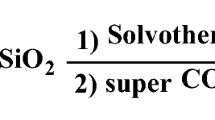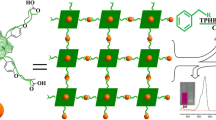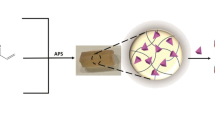Abstract
H2TCP and ZnTCP (TCP = 5,10,15,20-tetra(4-(phenoxy-4-yl)butanoic acid)porphyrin) were synthesized as gelator, reacted with Al(NO3)3·9H2O and Cr(NO3)3·9H2O by solvothermal and sol–gel method to give four organic–inorganic hybrid gels. The intermediate gels were extracted by supercritical CO2 to remove the redundant solvent molecules (DMF, EtOH) and the unreacted M3+ (M = Al, Cr), the final H2TCP-Al (PCP1), H2TCP-Cr (PCP2), ZnTCP-Al (PCP3), ZnTCP-Cr (PCP4) porous coordination polymers (PCPs) were obtained based on aerogels. The PCPs were characterized by FT-TR, UV–Vis, SEM, TEM and PXRD. Thermal stability and BET tests were carried by TGA and nitrogen sorption measurements. Results show that these PCPs exhibit superior thermal stability, tunable porosity and relative high BET surface ranging from 409 to 454 m2 g−1. Dyes adsorption experiments were performed to evaluate the adsorption capacity to dyes and the PCP3 has the best capacity which is 589 mg g−1 for rhodamine B (RhB) and 595 mg g−1 for methylene blue (MB). This work provides a promising method for the preparation of porous materials by supercritical CO2 extraction and exhibits some considerable applications in dyes adsorption.




Similar content being viewed by others
References
Guo CC, Li HP, Xu JB (1999) Study of synthesis of µ-oxo-bismanganese (III) porphyrin compounds and their catalysis of cyclohexane oxidation by PhIO. J Catal 185:345–351
Sun Q, Dai ZF, Meng XJ et al (2015) Task-specific design of porous polymer heterogeneous catalysts beyond homogeneous counterparts. ACS Catal 5:4556–4567
Zhang KN, Farha OK, Hupp JT et al (2015) Complete double epoxidation of divinylbenzene using Mn(porphyrin)-based porous organic polymers. ACS Catal 5:4859–4866
Hod I, Sampson MD, Deria P et al (2015) Fe-porphyrin-based metal-organic framework films as high-surface concentration, heterogeneous catalysts for electrochemical reduction of CO2. ACS Catal 5:6302–6309
Wang T, She YB, Fu HY et al (2016) Selective cyclohexane oxidation catalyzed by manganese porphyrins and co-catalysts. Catal Today 264:185–190
Johnson JA, Luo J, Zhang X et al (2015) Porphyrin-metalation-mediated tuning of photoredox catalytic properties in metal-organic frameworks. ACS Catal 5:5283–5291
Shu J, Qiu ZL, Zhuang JY et al (2015) In situ generation of electron donor to assist signal amplification on porphyrin-sensitized titanium dioxide nanostructures for ultrasensitive photoelectrochemical immunoassay. ACS Appl Mater Interfaces 7:23812–23818
Yella A, Lee HW, Tsao HN et al (2011) Porphyrin-sensitized solar cells with cobalt (II/III)-based redox electrolyte exceed 12 percent efficiency. Science 334:629–634
Sivalingam Y, Martinelli E, Catini A et al (2012) Gas-sensitive photoconductivity of porphyrin-functionalized ZnO nanorods. J Phys Chem C 116:9151–9157
Mathew S, Yella A, Gao P et al (2014) Dye-sensitized solar cells with 13% efficiency achieved through the molecular engineering of porphyrin sensitizers. Nat Chem 6:242–247
Gibson LE, Wright DW (2016) Sensitive method for biomolecule detection utilizing signal amplification with porphyrin nanoparticles. Anal Chem 88:5928–5933
Chang KW, Tang Y, Fang XF et al (2016) Incorporation of porphyrin to π-conjugated backbone for polymer-dot-sensitized photodynamic therapy. Biomacromol 17:2128–2136
Pandey RK, Smith KM, Dougherty TJ (1990) Porphyrin dimers as photosensitizers in photodynamic therapy. J Med Chem 33:2032–2038
Schmitt F, Govindaswamy P, Süss-Fink G et al (2008) Ruthenium porphyrin compounds for photodynamic therapy of cancer. J Med Chem 51:1811–1816
Guo CC, Song JX, Chen XB et al (2000) A new evidence of the high-valent oxo-metal radical cation intermediate and hydrogen radical abstract mechanism in hydrocarbon hydroxylation catalyzed by metalloporphyrins. J Mol Catal A Chem 157:31–40
Alkordi MH, Liu YL, Larsen RW et al (2008) Zeolite-like metal-organic frameworks as platforms for applications: on metalloporphyrin-based catalysts. J Am Chem Soc 130:12639–12641
Sun Q, Dai ZF, Meng XJ et al (2015) Porous polymer catalysts with hierarchical structures. Chem Soc Rev 44:6018–6034
Sun Q, Aguila B, Verma G et al (2016) Superhydrophobicity: constructing homogeneous catalysts into super hydrophobic porous frameworks to protect them from hydrolytic degradation. Chem 1:628–639
Sun Q, Dai ZF, Meng XJ et al (2017) Homochiral porous framework as a platform for durability enhancement of molecular catalysts. Chem Mater 29:5720–5726
Ma TY, Li H, Tang AN et al (2011) Ordered, mesoporous metal phosphonate materials with microporous crystalline walls for selective separation techniques. Small 13:1827–1837
Shi L, Chu ZY, Liu Y et al (2014) In situ fabrication of three-dimensional graphene films on gold substrates with controllable pore structures for high-performance electrochemical sensing. Adv Funct Mater 24:7032–7041
Zou C, Zhang TF, Xie MH et al (2013) Four metalloporphyrinic frameworks as heterogeneous catalysts for selective oxidation and aldol reaction. Inorg Chem 52:3620–3626
Feng DW, Gu ZY, Li JR et al (2012) Zirconium-metalloporphyrin PCN-222: mesoporous metal-organic frameworks with ultrahigh stability as biomimetic catalysts. Angew Chem 124:10453–10456
Yoon MY, Srirambalaji R, Kim K (2012) Homochiral metal-organic frameworks for asymmetric heterogeneous catalysis. Chem Rev 112:1196–1231
Wan S, Guo J, Kim J et al (2008) A belt-shaped, blue iuminescent, and semiconducting covalent organic framework. Angew Chem 120:8958–8962
Huh S, Kim SJ, Kim Y (2016) Porphyrinic metal–organic frameworks from custom-designed porphyrins. CrystEngComm 18:345–368
Kaur P, Hupp JT, Nguyen ST (2011) Porous organic polymers in catalysis: opportunities and challenges. ACS Catal 1:819–835
Meng L, Cheng QG, Kim C et al (2012) Crystal engineering of a microporous, catalytically active fcu topology MOF using a custom-designed metalloporphyrin linker. Angew Chem Int Ed 51:10082–10085
Wang KC, Feng DW, Liu TF et al (2014) A series of highly stable mesoporous metalloporphyrin Fe-MOFs. J Am Chem Soc 136:13983–13986
Zhang XT, Sui ZY, Xu B et al (2011) Mechanically strong and highly conductive graphene aerogel and its use as electrodes for electrochemical power sources. J Mater Chem 21:6494–6497
Xiang SL, Li L, Zhang JY et al (2012) Porous organic-inorganic hybrid aerogels based on Cr3+/Fe3+ and rigid bridging carboxylates. J Mater Chem 22:1862–1867
Sato T, Mori W, Kato CN et al (2005) Novel microporous rhodium(II) carboxylate polymer complexes containing metalloporphyrin: syntheses and catalytic performances in hydrogenation of olefins. J Catal 232:186–198
Mori W, Sato T, Kato CN et al (2005) Discovery and development of microporous metal carboxylates. Chem Rec 5:336–351
Zhang ZQ, Su XQ, Yu F et al (2016) Three novel metal–organic frameworks based on flexible porphyrin tetracarboxylic acids as highly effective catalysts. J Solid State Chem 238:53–59
Zhao X, Yuan L, Zhang ZQ et al (2016) Synthetic methodology for the fabrication of porous porphyrin materials with metal-organic-polymer aerogels. Inorg Chem 55:5287–5296
Sun S, Yu Q, Zhang W et al (2017) Metalloporphyrin-based porous coordination polymers: synthesis, served as heterogenous catalysts and dye scavengers. Catal Lett 147:228–239
Maiti NC, Mazumdar S, Periasamy N (1998) J- and H-aggregates of porphyrin-surfactant complexes: time-resolved fluorescence and other spectroscopic studies. J Phys Chem B 102:1528–1538
D’Urso A, Fragalà ME, Purrello R (2012) From self-assembly to noncovalent synthesis of programmable porphyrins’ arrays in aqueous solution. Chem Commun 48:8165–8176
Sun ZC, She YB, Zhou Y (2011) Synthesis, characterization and spectral properties of substituted tetraphenylporphyrin iron chloride complexes. Molecules 16:2960–2970
Yao L, He JH, Li T et al (2016) Novel SiO2/H2Ti2O5 H2O-nanochain composite with high UV-visible photocatalytic activity for supertransparent multifunctional thin films. Langmuir 32:13611–13619
Liu XM, Sigen A, Zhang YW et al (2014) A porphyrin-linked conjugated microporous polymer with selective carbon dioxide adsorption and heterogeneous organocatalytic performances. RSC Adv 4:6447–6453
Groen JC, Peffer LAA, Pérez-Ramírez J (2003) Pore size determination in modified micro-and Mesoporous materials. Pitfalls and limitations in gas adsorption data analysis. Micropor Mesopor Mat 60:1–17
Zhu WC, Cui XL, Liu XF (2013) Hydrothermal evolution, optical and electrochemical properties of hierarchical porous hematite nanoarchitectures. Nanoscale Res Lett 8:2
Ren Y, Hardwick LJ, Bruce PG (2010) Lithium intercalation into mesoporous anatase with an ordered 3D pore structure. Angew Chem 122:2624–2628
Acknowledgements
The authors gratefully acknowledge the National Natural Science Foundation of China (Grant nos. 21671158, 21271148 and 21773184) for financial support of this work.
Author information
Authors and Affiliations
Corresponding authors
Electronic supplementary material
Below is the link to the electronic supplementary material.
Rights and permissions
About this article
Cite this article
Xu, Y., Yu, Q., Zhao, D. et al. Synthesis and characterization of porphyrin-based porous coordination polymers obtained by supercritical CO2 extraction. J Mater Sci 53, 10534–10542 (2018). https://doi.org/10.1007/s10853-018-2305-5
Received:
Accepted:
Published:
Issue Date:
DOI: https://doi.org/10.1007/s10853-018-2305-5




